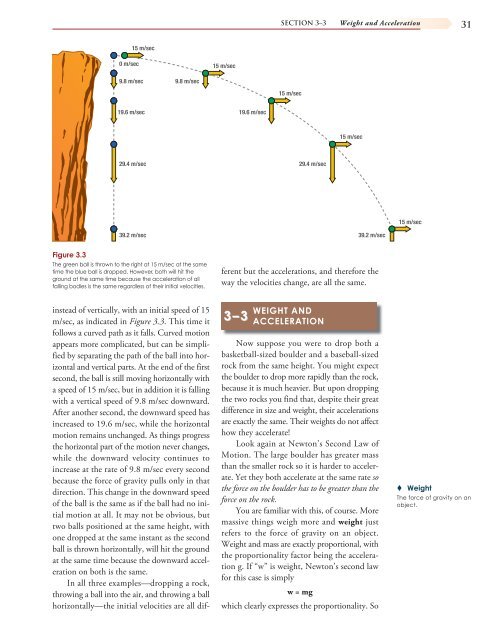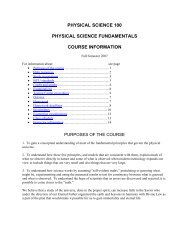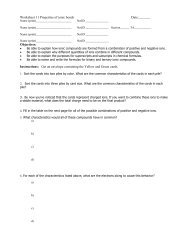knowledge, science, and the universe chapter 1 - Physical Science ...
knowledge, science, and the universe chapter 1 - Physical Science ...
knowledge, science, and the universe chapter 1 - Physical Science ...
You also want an ePaper? Increase the reach of your titles
YUMPU automatically turns print PDFs into web optimized ePapers that Google loves.
SECTION 3–3 Weight <strong>and</strong> Acceleration 31<br />
15 m/sec<br />
0 m/sec 15 m/sec<br />
9.8 m/sec<br />
9.8 m/sec<br />
15 m/sec<br />
19.6 m/sec<br />
19.6 m/sec<br />
15 m/sec<br />
29.4 m/sec<br />
29.4 m/sec<br />
15 m/sec<br />
39.2 m/sec<br />
39.2 m/sec<br />
figure 3.3<br />
The green ball is thrown to <strong>the</strong> right at 15 m/sec at <strong>the</strong> same<br />
time <strong>the</strong> blue ball is dropped. However, both will hit <strong>the</strong><br />
ground at <strong>the</strong> same time because <strong>the</strong> acceleration of all<br />
falling bodies is <strong>the</strong> same regardless of <strong>the</strong>ir initial velocities.<br />
instead of vertically, with an initial speed of 15<br />
m/sec, as indicated in Figure 3.3. This time it<br />
follows a curved path as it falls. Curved motion<br />
appears more complicated, but can be simplified<br />
by separating <strong>the</strong> path of <strong>the</strong> ball into horizontal<br />
<strong>and</strong> vertical parts. At <strong>the</strong> end of <strong>the</strong> first<br />
second, <strong>the</strong> ball is still moving horizontally with<br />
a speed of 15 m/sec, but in addition it is falling<br />
with a vertical speed of 9.8 m/sec downward.<br />
After ano<strong>the</strong>r second, <strong>the</strong> downward speed has<br />
increased to 19.6 m/sec, while <strong>the</strong> horizontal<br />
motion remains unchanged. As things progress<br />
<strong>the</strong> horizontal part of <strong>the</strong> motion never changes,<br />
while <strong>the</strong> downward velocity continues to<br />
increase at <strong>the</strong> rate of 9.8 m/sec every second<br />
because <strong>the</strong> force of gravity pulls only in that<br />
direction. This change in <strong>the</strong> downward speed<br />
of <strong>the</strong> ball is <strong>the</strong> same as if <strong>the</strong> ball had no initial<br />
motion at all. It may not be obvious, but<br />
two balls positioned at <strong>the</strong> same height, with<br />
one dropped at <strong>the</strong> same instant as <strong>the</strong> second<br />
ball is thrown horizontally, will hit <strong>the</strong> ground<br />
at <strong>the</strong> same time because <strong>the</strong> downward acceleration<br />
on both is <strong>the</strong> same.<br />
In all three examples—dropping a rock,<br />
throwing a ball into <strong>the</strong> air, <strong>and</strong> throwing a ball<br />
horizontally—<strong>the</strong> initial velocities are all different<br />
but <strong>the</strong> accelerations, <strong>and</strong> <strong>the</strong>refore <strong>the</strong><br />
way <strong>the</strong> velocities change, are all <strong>the</strong> same.<br />
3–3 wEIGhT ANd<br />
ACCELERATION<br />
Now suppose you were to drop both a<br />
basketball- sized boulder <strong>and</strong> a baseball- sized<br />
rock from <strong>the</strong> same height. You might expect<br />
<strong>the</strong> boulder to drop more rapidly than <strong>the</strong> rock,<br />
because it is much heavier. But upon dropping<br />
<strong>the</strong> two rocks you find that, despite <strong>the</strong>ir great<br />
difference in size <strong>and</strong> weight, <strong>the</strong>ir accelerations<br />
are exactly <strong>the</strong> same. Their weights do not affect<br />
how <strong>the</strong>y accelerate!<br />
Look again at Newton’s Second Law of<br />
Motion. The large boulder has greater mass<br />
than <strong>the</strong> smaller rock so it is harder to accelerate.<br />
Yet <strong>the</strong>y both accelerate at <strong>the</strong> same rate so<br />
<strong>the</strong> force on <strong>the</strong> boulder has to be greater than <strong>the</strong><br />
force on <strong>the</strong> rock.<br />
You are familiar with this, of course. More<br />
massive things weigh more <strong>and</strong> weight just<br />
refers to <strong>the</strong> force of gravity on an object.<br />
Weight <strong>and</strong> mass are exactly proportional, with<br />
<strong>the</strong> proportionality factor being <strong>the</strong> acceleration<br />
g. If “w” is weight, Newton’s second law<br />
for this case is simply<br />
w = mg<br />
which clearly expresses <strong>the</strong> proportionality. So<br />
weight<br />
The force of gravity on an<br />
object.






